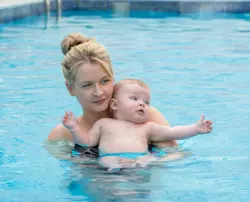 “I started off going to baby swimming classes, and we both loved it! Suddenly, my baby swimmer has become a little toddler, a little wilful, and seems far less happy to put his face in the water. Should I buy him some goggles?”
“I started off going to baby swimming classes, and we both loved it! Suddenly, my baby swimmer has become a little toddler, a little wilful, and seems far less happy to put his face in the water. Should I buy him some goggles?”
The above question is one that needs careful attention when answering. The reason may be that your toddler is now swimming for a larger part of the lesson with their face in the water, so their eyes may be getting a little sore. Or they may have discovered that they have sufficient strength in their neck and back to lift their head out of the water when swimming. This will be a real novelty to them, but should be discouraged as it makes swimming very inefficient and difficult.
Goggles could help your toddler swimming and encourage your toddler to put their face back in the water. Their eyes will be less aggravated and they will undoubtedly enjoy their enhanced vision with goggles on – especially when collecting toys from the pool floor.
However, goggles are not always the right answer. It is very easy for a small child to quickly become dependent on goggles and refuse to even get into the water without them. Goggles are also cumbersome, don’t always seal correctly and, worst of all, are difficult for toddler to put on but very easy for them to take off!
Goggle dependency can become a genuine safety issue. One of the key benefits of baby swimming and toddler swimming is to make your child as safe as possible around water. Any child, of any age, could fall into water. It is most likely that your child will be fully clothed and not wearing goggles if they ever fell into water, therefore it is important that they do not develop a mindset that they cannot swim without their goggles on. Remember, your toddler may have spent more than two years swimming as a baby without goggles.
We have very specific guidelines which may help you decide whether to give your toddler goggles:
- Do not put goggles on children under two years, and ideally not on children under three years.
- Encourage head down and underwater swimming without goggles first. Goggles should be a last resort.
- Never let your child jump in with goggles on because they could slip and hurt your child’s face.
- They should regularly resurface and swim without goggles on.
- Take goggles off occasionally to “practise lifesaving”.
- Make sure the goggles are well-fitting.
- Don’t allow a child to wear goggles if they cannot keep them on!
Above all, if your child does want goggles then don’t make a big issue out of it. Encourage your child to keep them on for a period of time (while doing most of the swimming and diving activities) but make sure they are removed for at least some of each swimming session, and certainly when your child is jumping.
-

If you decide to get your little one goggles, we have a whole range to choose from in our shop, including 5 different colours, UV protection, anti-fog & scratch resistant lenses, waterproof seals and free of any latex.
Visit the shop


